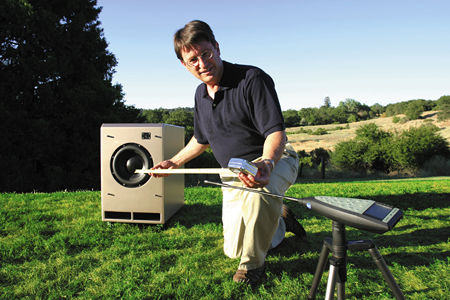Way Down Deep I Test Methodology
1. Conduct the tests outdoors, including the listening tests. This eliminates room gain, which enables any sub to play louder in a room, with lower distortion, than it can outdoors. However, testing outdoors also eliminates destructive subwoofer/room interactions, including room modes that vary from space to space.
2. Run the tests at least three times on each subwoofer, typically on different days.
3. Test at several output levels. Drive the subwoofers at playback levels of 80, 90, 100, 105, 110, 115, and, in a few extreme cases, 120dB.

4. Graph the effects of power compression. As the output level increases, more and more of the signal energy is wasted heating up the voice coil, giving you less and less output with each successive increase. This leads to the obvious blunting of dynamic impact and a leaning-out of tonal quality as the sub's output falls further behind the main speakers.
5. Test maximum level before audible distortion. Feed each sub a sequence of shaped tone bursts at various levels, and at frequencies on standard one-third octave centers. These "boinker" signals (produced by Siegfried Linkwitz) exercise drivers to their limits, but they are so short that they don't sound very loud to humans, and they don't have a chance to create a thermal problem for the driver's voice coil. The distortion components are plainly audible.
6. Audition each sub at playback levels that never exceed its maximum "undistorted" capability. Slowly increase subwoofer level until distortion became audible, backing off 1dB. Use this level for the "waterfall" measurements and the all-speakers-on listening session.
7. Include plots of the subs' responses on popular soundtracks as opposed to just test tones. After a short tutorial, even a casual reader can glance at a spectrograph (or "waterfall") plot of a 10-second movie clip and quickly compare how accurately the sub played what was on the recording.
8. Be a fussy, obsessive audiophile. For some manufacturers, I was considered an "audiophile," "fussy," even "obsessive"—a guy whose taste admittedly runs more to Handel operas and O Brother, Where Art Thou? than hip-hop and Terminator 10.
9. Use really good test equipment. Most speaker engineers I know would love to get their hands on a state-of-the-art Brüel & Kjær sound-level meter like the flagship model I used, but at $40,000 all kitted out, the 2260 Investigator is beyond the reach of all but the biggest labs. Same with the measurement microphones, mike calibrator, analyzer, and the hard drive's worth of analysis programs I use almost every day.
Keith Yates
- Log in or register to post comments



































































